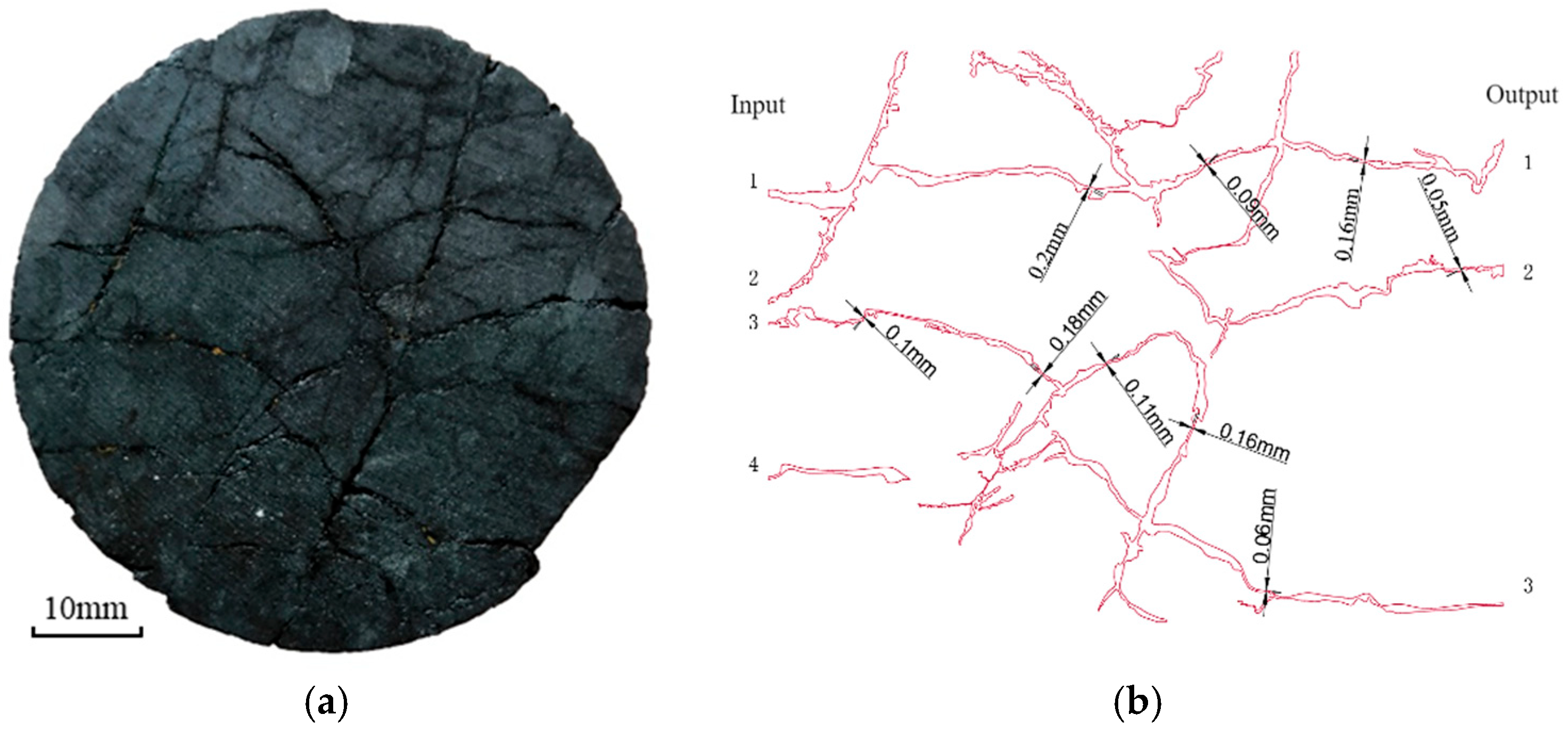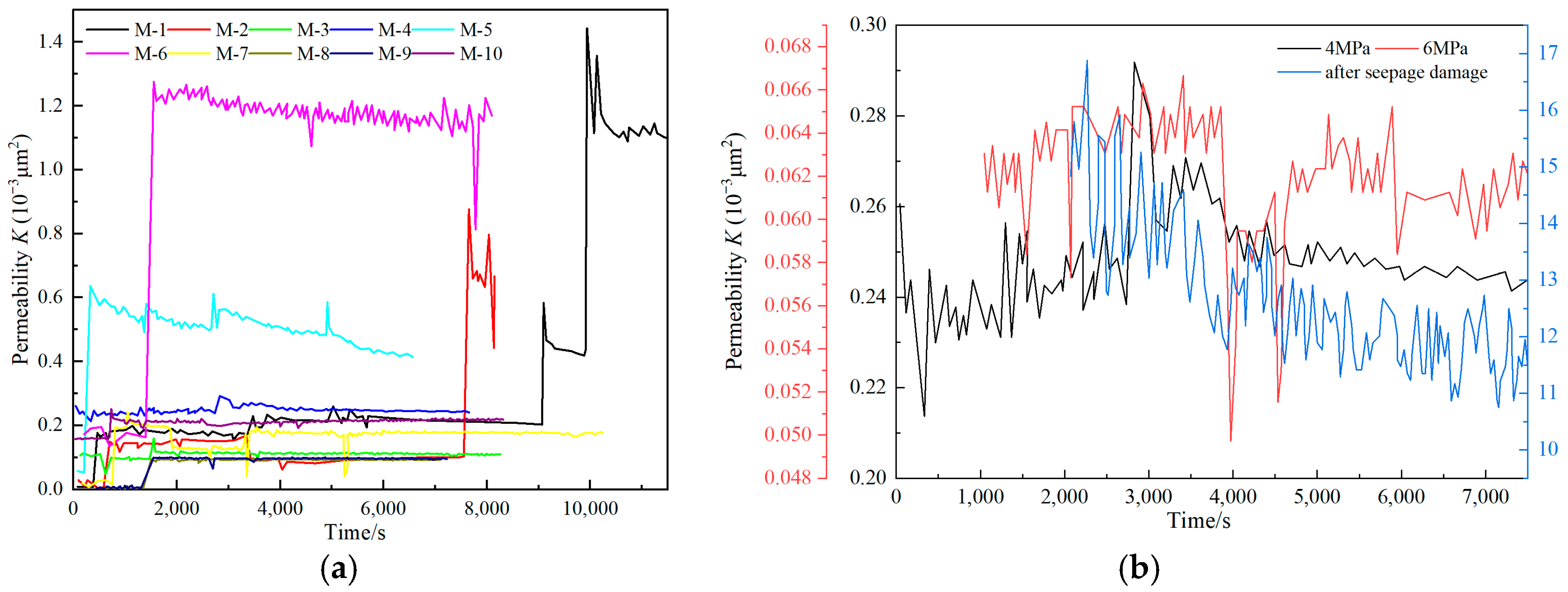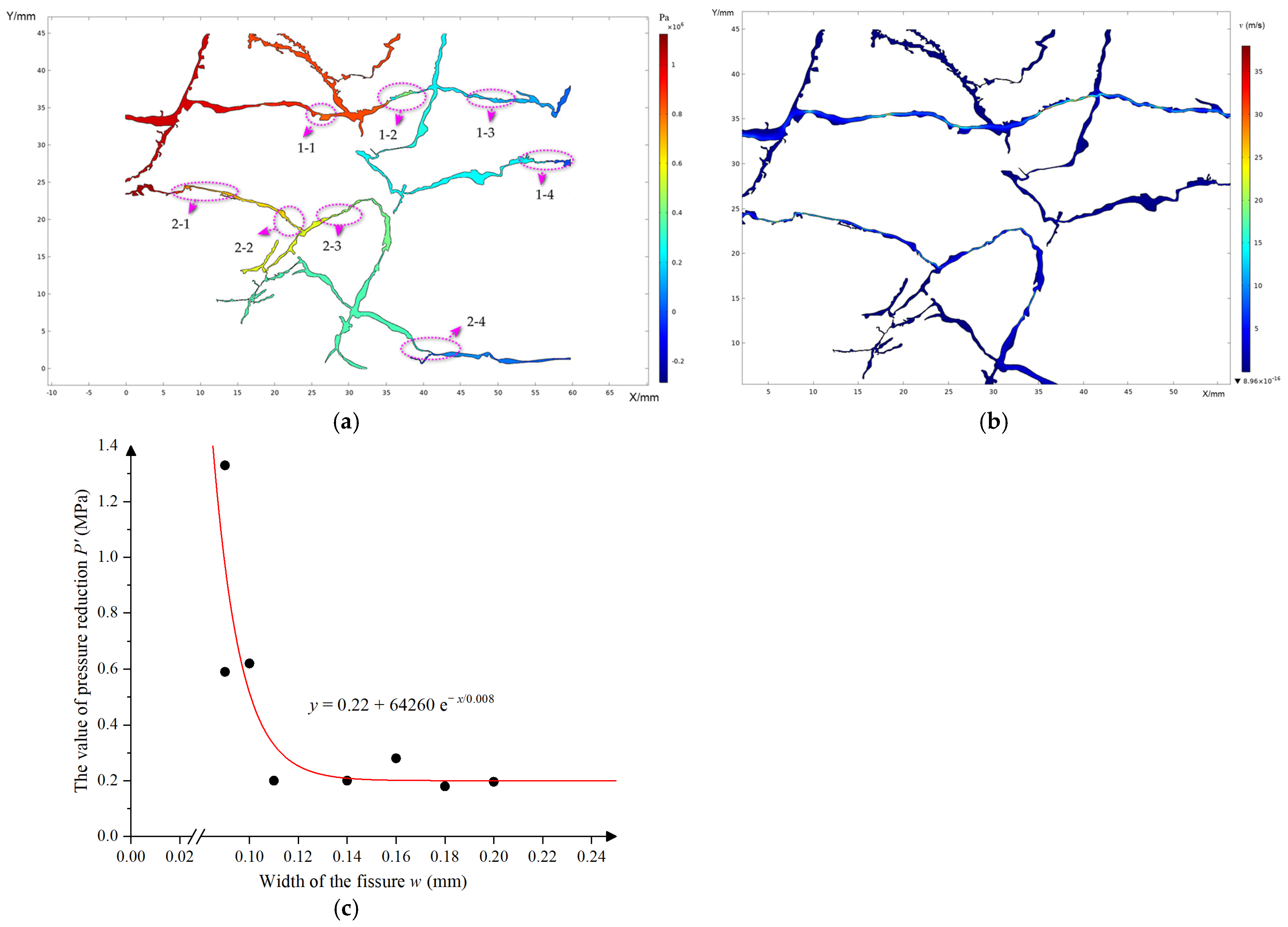Research on the Characteristics of Seepage Failure in the Surrounding Rock (Coal) of the Goafs
Abstract
:1. Introduction
2. Materials and Methods
2.1. Preparation of Coal Samples
2.2. Experimental Principles and Procedures
- Check the Instrument: Before inserting the core, check the instrument to ensure that the confining pressure has been released, remove the end caps, and ensure that there are no cores or spacers in the holder. Prepare for the experiment.
- Insert the Coal Sample: Wrap the prepared coal sample with waterstop tape and insert it into the holder. Fix the end caps with two protruding clips, aligning them with the grooves on the end cover, and rotate clockwise about 1/4 turn until it cannot be turned further, ensuring the position is fixed while tightening the adjustment cap.
- Insert Spacers: Insert appropriate length spacers based on the coal sample length (30 mm), ensuring the total length of the core and spacers is within 80–100 mm.
- Check Sealing: After inserting the test sample, turn the adjustment sleeve counterclockwise by hand. If it moves easily, tighten it further. Ensure the sleeve is tight and not easy to move, completing the inspection.
- Apply Confining Pressure: Manually pressurize the confining pressure pump. After loading the confining pressure, check the stability and reliability of the seepage system. If there is any pressure relief, check for leaks and repair them promptly to ensure the instrument works properly.
- Inject Water Flow: Turn on the water injection system, slowly permeate the sample with a constant flow rate of 1 mL/min, observe for leaks, and simultaneously turn on the data acquisition system and zero it, recording data in real-time.
- Set Monitoring System: Set various parameters as required and save the data promptly to prevent data loss.
- Export and Analyze Data: After the experiment, export and save the data promptly and perform data analysis.
2.3. Method of Simulation of Fissure Seepage
3. Results and Discussion
3.1. Test Results of Coal Samples
- Stable Stage and Mutation Stage:
- 2.
- Effect of Confining Pressure:
3.2. Analysis of Permeability Variation Causes
3.3. Implications of Fissure Seepage for Water Gushing-Out from Simulation Result
4. Conclusions
Author Contributions
Funding
Institutional Review Board Statement
Informed Consent Statement
Data Availability Statement
Acknowledgments
Conflicts of Interest
References
- Meng, Z.; Li, G.; Xie, X. A Geological Assessment Method of Floor Water Inrush Risk and Its Application. Eng. Geol. 2012, 143–144, 51–60. [Google Scholar] [CrossRef]
- Dai, G.; Xue, X.; Xu, K.; Dong, L.; Niu, C. A GIS-Based Method of Risk Assessment on No.11 Coal-Floor Water Inrush from Ordovician Limestone in Hancheng Mining Area, China. Arab. J. Geosci. 2018, 11, 714. [Google Scholar] [CrossRef]
- Li, Y.M. Research on Stability of Overlying Strata and Reasonable Waterproof Coal Pillar with Backfilling Mining in Steep Seam under Water Body. Ph.D. Thesis, China University of Mining and Technology, Xuzhou, China, 2012. [Google Scholar]
- Luo, B. Reseach on the Mechanism of Water-conducted Fractures in Rock and Coal Near the Goafs. Ph.D. Thesis, China University of Mining and Technology, Xuzhou, China, 2021. [Google Scholar]
- Sun, Q. Analysis of seepage processes within coal rock bodies under pressure water sources. Saf. Coal Mines 2006, 2, 58–59. [Google Scholar]
- Li, S.; Fan, C.; Han, J.; Luo, M.; Yang, Z.; Bi, H. A Fully Coupled Thermal-Hydraulic-Mechanical Model with Two-Phase Flow for Coalbed Methane Extraction. J. Nat. Gas Sci. Eng. 2016, 33, 324–336. [Google Scholar] [CrossRef]
- Shu, Y.; Sang, S.; Zhou, X.; Zhao, F. A Coupled Hydraulic–Mechanical Model with Two-Phase Flow for Fracturing Development of Undersaturated Coalbed Methane Reservoirs Considering Permeability Velocity-Sensitive Damage. Nat. Resour. Res. 2023, 32, 2053–2076. [Google Scholar] [CrossRef]
- Huang, F.; Kang, Y.; You, L.; Li, X.; You, Z. Massive Fines Detachment Induced by Moving Gas-Water Interfaces during Early Stage Two-Phase Flow in Coalbed Methane Reservoirs. Fuel 2018, 222, 193–206. [Google Scholar] [CrossRef]
- Du, Z. Study on Theoretics of Hydraulicfracturing in Coal Bed and Its Applications. Ph.D. Thesis, China University of Mining and Technology, Xuzhou, China, 2008. [Google Scholar]
- Yao, Q.; Li, Y.; Li, X.; Yu, L.; Zheng, C. Permeation–Strain Characteristics and Damage Constitutive Model of Coal Samples under the Coupling Effect of Seepage and Creep. Int. J. Rock Mech. Min. Sci. 2024, 177, 105729. [Google Scholar] [CrossRef]
- Lin, F.; Huang, G.; Jiang, D.; He, Y.; Fan, J. Experimental Study on Coal Permeability and Damage Evolution Under the Seepage-Stress Coupling. Front. Earth Sci. 2022, 10, 847392. [Google Scholar] [CrossRef]
- Wen, G.; Yang, S.; Liu, Y.; Wu, W.; Sun, D.; Wang, K. Influence of Water Soaking on Swelling and Microcharacteristics of Coal. Energy Sci. Eng. 2020, 8, 50–60. [Google Scholar] [CrossRef]
- Huang, Z.; Zhao, X.; Gao, Y.; Shao, Z.; Zhang, Y.; Liu, X. The Influence of Water Immersion on the Physical and Chemical Structure of Coal. Combust. Sci. Technol. 2022, 194, 1136–1154. [Google Scholar] [CrossRef]
- Zhang, Y.; Qi, X.; Zou, J.; Rao, Y.; Chen, L.; Zhang, L.; Ji, Y.; Liang, Z. Effects of Water Immersion on the Pore Structure and Thermodynamic Properties of Coal Gangue. Fuel 2023, 346, 128273. [Google Scholar] [CrossRef]
- Lu, Y.; Ye, M.; Ge, Z.; Zhou, Z.; Gong, S.; Wang, Z.; Huang, S.; Guan, Y. Study on the Evolution Mechanism and Compression Effect of Coal Pores Subjected to Water Injection. Energy Fuels 2022, 36, 887–896. [Google Scholar] [CrossRef]
- Lu, Y.; Wang, L.; Ge, Z.; Zhou, Z.; Deng, K.; Zuo, S. Fracture and Pore Structure Dynamic Evolution of Coals during Hydraulic Fracturing. Fuel 2020, 259, 116272. [Google Scholar] [CrossRef]
- Perera, M.S.A.; Ranjith, P.G.; Peter, M. Effects of Saturation Medium and Pressure on Strength Parameters of Latrobe Valley Brown Coal: Carbon Dioxide, Water and Nitrogen Saturations. Energy 2011, 36, 6941–6947. [Google Scholar] [CrossRef]
- Zhou, G.; Wang, C.; Liu, R.; Li, S.; Zhang, Q.; Liu, Z.; Yang, W. Synthesis and Characterization of Water Injection Fracturing Fluid for Wetting and Softening Coal Seam. Int. J. Rock Mech. Min. Sci. 2022, 150, 105024. [Google Scholar] [CrossRef]
- Liu, Z.; Wang, G.; Li, J.; Li, H.; Zhao, H.; Shi, H.; Lan, J. Water-Immersion Softening Mechanism of Coal Rock Mass Based on Split Hopkinson Pressure Bar Experiment. Int. J. Coal Sci. Technol. 2022, 9, 61. [Google Scholar] [CrossRef]
- Lu, W. Experimental Study on the Influence of Water Accumulation in the Mined-out Space on the Stability of Water Proof Coal and Rock Pillar in Ximing Coalmine. Master’s Thesis, China University of Mining and Technology, Xuzhou, China, 2022. [Google Scholar]
- Liu, Q.; Xue, Y.; Ma, D.; Li, Q. Failure Characteristics of the Water-Resisting Coal Pillar under Stress-Seepage Coupling and Determination of Reasonable Coal Pillar Width. Water 2023, 15, 1002. [Google Scholar] [CrossRef]
- Chen, D.; Wang, X.; Bai, J.; Li, M. Characteristics of Waterproof Failure and Optimal Width of Narrow Coal Pillars under the Coupled Effects of Mining, Excavation and Seepage. Geomech. Geophys. Geo-Energy Geo-Resour. 2024, 10, 100. [Google Scholar] [CrossRef]
- Huang, P.; Zhang, Q.; Xie, J.; Li, J.; Zhang, Q.; Li, M.; Simao, F.C. Multiscale Study on Coal Pillar Strength and Rational Size under Variable Width Working Face. Front. Environ. Sci. 2024, 12, 1338642. [Google Scholar] [CrossRef]
- Fan, J.; Li, Z.; Feng, G.; Zhang, H.; Qi, C.; Zhang, J. Failure Analysis of Coal Pillars and Overburden from Underground Water Reservoir under the Mining-Water Invasion Coupling Effect. Eng. Fail. Anal. 2023, 151, 107406. [Google Scholar] [CrossRef]
- Jia, W.; Zhou, H.; Xie, S.; Wang, Y.; Hu, X.; Zhang, L. Pore-Pressure and Stress-Coupled Creep Behavior in Deep Coal: Insights from Real-Time NMR Analysis. Int. J. Min. Sci. Technol. 2024, 34, 77–90. [Google Scholar] [CrossRef]
- Guo, Z.; Vu, P.N.H.; Hussain, F. A Laboratory Study of the Effect of Creep and Fines Migration on Coal Permeability during Single-Phase Flow. Int. J. Coal Geol. 2018, 200, 61–76. [Google Scholar] [CrossRef]
- Fernandez, G.; Moon, J. Excavation-Induced Hydraulic Conductivity Reduction around a Tunnel—Part 1: Guideline for Estimate of Ground Water Inflow Rate. Tunn. Undergr. Space Technol. 2010, 25, 560–566. [Google Scholar] [CrossRef]
- Fernandez, G.; Moon, J. Excavation-Induced Hydraulic Conductivity Reduction around a Tunnel—Part 2: Verification of Proposed Method Using Numerical Modeling. Tunn. Undergr. Space Technol. 2010, 25, 567–574. [Google Scholar] [CrossRef]
- Rutqvist, J.; Noorishad, J.; Tsang, C.-F.; Stephansson, O. Determination of Fracture Storativity in Hard Rocks Using High-Pressure Injection Testing. Water Resour. Res. 1998, 34, 2551–2560. [Google Scholar] [CrossRef]
- Heiland, J. Laboratory Testing of Coupled Hydro-Mechanical Processes during Rock Deformation. Hydrogeol. J. 2003, 11, 122–141. [Google Scholar] [CrossRef]
- Chen, Y.-F.; Zhou, J.-Q.; Hu, S.-H.; Hu, R.; Zhou, C.-B. Evaluation of Forchheimer Equation Coefficients for Non-Darcy Flow in Deformable Rough-Walled Fractures. J. Hydrol. 2015, 529, 993–1006. [Google Scholar] [CrossRef]
- Nader, J.J. Darcy’s Law and the Differential Equation of Motion. Géotechnique 2009, 59, 551–552. [Google Scholar] [CrossRef]
- Simmons, C.T. Henry Darcy (1803–1858): Immortalised by His Scientific Legacy. Hydrogeol. J. 2008, 16, 1023–1038. [Google Scholar] [CrossRef]
- Xia, H.; Zhang, H.; Zhang, J. Research on Damage Mechanism and Mechanical Characteristics of Coal Rock under Water Immersion. Sustainability 2023, 15, 13095. [Google Scholar] [CrossRef]
- Liu, Y.; Zhao, D.; Li, Y.; Zhang, L. Permeability Evolution of Intact and Fractured Coal during Progressive Deformation Subjected to True Triaxial Stresses. Processes 2023, 11, 2826. [Google Scholar] [CrossRef]
- Cao, W.; Lei, Q.; Cai, W. Stress-Dependent Deformation and Permeability of a Fractured Coal Subject to Excavation-Related Loading Paths. Rock Mech. Rock Eng. 2021, 54, 4299–4320. [Google Scholar] [CrossRef]
- Wang, S.; Elsworth, D.; Liu, J. Permeability evolution in fractured coal: The roles of fracture geometry and water-content. Int. J. Coal Geol. 2011, 87, 13–25. [Google Scholar] [CrossRef]






| Coal Sample Number | Diameter (mm) | Length (mm) | Mass (g) | Volumetric Weight (N/m3) | Fissure Development |
|---|---|---|---|---|---|
| M-1 | 24.76 | 30.10 | 17.20 | 12.32 | 3 microfractures |
| M-2 | 24.82 | 30.22 | 19.23 | 12.96 | 1 microfractures |
| M-3 | 24.82 | 30.24 | 19.19 | 12.80 | 2 microfractures |
| M-4 | 24.74 | 30.00 | 16.81 | 12.32 | 1 microfractures |
| M-5 | 24.82 | 30.20 | 17.82 | 13.01 | One X-shaped microfissure |
| M-6 | 24.74 | 30.12 | 20.21 | 15.02 | Multiple microfissures |
| M-7 | 24.86 | 30.10 | 19.97 | 13.18 | 1 microfractures |
| M-8 | 24.78 | 30.20 | 17.23 | 12.60 | 1 microfractures |
| M-9 | 24.72 | 30.12 | 19.38 | 12.83 | Multiple microfissures |
| M-10 | 24.88 | 30.20 | 19.26 | 13.01 | Multiple microfissures |
| Confining Pressure PC (MPa) | Axial Compression PA (MPa) | Water Injection Flow q (mL/min) |
|---|---|---|
| 4.0 | 4.0 | 2.0 |
| Sample | Permeability K (10−3 μm2) | Sample | Permeability K (10−3 μm2) |
|---|---|---|---|
| M-1 | 0.2 | M-6 | 1.2 |
| M-2 | 0.15 | M-7 | 0.13 |
| M-3 | 0.11 | M-8 | 0.09 |
| M-4 | 0.24 | M-9 | 0.10 |
| M-5 | 0.5 | M-10 | 0.22 |
| Number | 1-1 | 1-2 | 1-3 | 1-4 | 2-1 | 2-2 | 2-3 | 2-4 |
|---|---|---|---|---|---|---|---|---|
| Width of the fissure w (mm) | 0.20 | 0.09 | 0.16 | 0.14 | 0.10 | 0.18 | 0.11 | 0.09 |
| The value of pressure reduction p′ (MPa) | 0.19 | 1.33 | 0.28 | 0.20 | 0.62 | 0.18 | 0.20 | 0.59 |
Disclaimer/Publisher’s Note: The statements, opinions and data contained in all publications are solely those of the individual author(s) and contributor(s) and not of MDPI and/or the editor(s). MDPI and/or the editor(s) disclaim responsibility for any injury to people or property resulting from any ideas, methods, instructions or products referred to in the content. |
© 2024 by the authors. Licensee MDPI, Basel, Switzerland. This article is an open access article distributed under the terms and conditions of the Creative Commons Attribution (CC BY) license (https://creativecommons.org/licenses/by/4.0/).
Share and Cite
Luo, B.; Zhang, C.; Zhang, P.; Huo, J. Research on the Characteristics of Seepage Failure in the Surrounding Rock (Coal) of the Goafs. Appl. Sci. 2024, 14, 9210. https://doi.org/10.3390/app14209210
Luo B, Zhang C, Zhang P, Huo J. Research on the Characteristics of Seepage Failure in the Surrounding Rock (Coal) of the Goafs. Applied Sciences. 2024; 14(20):9210. https://doi.org/10.3390/app14209210
Chicago/Turabian StyleLuo, Bin, Chenghang Zhang, Peng Zhang, and Jiayi Huo. 2024. "Research on the Characteristics of Seepage Failure in the Surrounding Rock (Coal) of the Goafs" Applied Sciences 14, no. 20: 9210. https://doi.org/10.3390/app14209210





